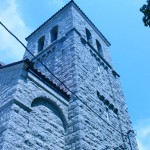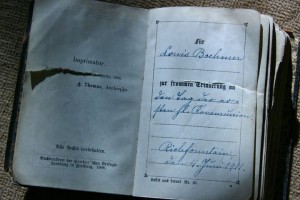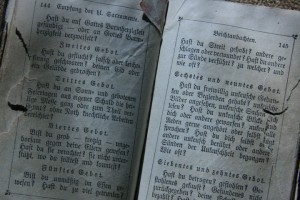This is the first in an occasional series of travelogue/photo essays on seeing and experiencing intersections of faith, history and culture — on seeing new and old communities of faith.

On Friday, Sue and I drove around the Missouri River Valley of Central Missouri just east of our state capital of Jefferson City, an area settled and farmed largely by 19th– and 20th-century German immigrants. They were drawn to the area, in large part, by its fertile river valley and its similarities to their homeland, and the marks they left on the landscape are still present in the cleared and plowed fields, a few old stone buildings, and their churches — both Catholic and Protestant – whose spires spring up from the land as you approach any village or town on the narrow, winding roads. Always, there is a church steeple signaling the existence of a community.
We hit just a few towns on this short road trip. When I see the town of Frankenstein on the map, I know we have to go see it. Besides the intrigue of the name, I have been there before many years ago when I was a child, as friends of our family owned a “country place” not far away up Highway 100 in Osage County. There’s not much to see now in Frankenstein, if there ever was, but its Catholic Church – Our Lady, Help of Christians – is a

wonderful and well-preserved architectural specimen, especially considering the town currently boasts a population of 30 people. The town, at least according to one online source, was named not for the monster but for Gottfried Franken, who donated land to build the church in 1890.
From Frankenstein, we double back, heading south again through Linn and Loose Creek to the German Catholic village of Westphalia, home to St. Joseph Catholic Church, founded in 1835. Many of the early settlers of the area came from the Westphalen area of Germany, thus the name of the village.
The massive stone church building, typical of 19th-century German architecture, looms large over the town. Up close, you can still see the hand-hewn marks on the off-white stones. Someone sweated over these stones and then lugged them up the hill and mortared them into place. Someone prayed over them and dedicated them to worship and prayer. Someone hoped that 150 years later these walls would still be standing, echoing back the prayers and songs and sacraments of a community of faith. To stand outside the walls and consider the baptisms and first communions and weddings and funerals is to see the history of an entire community in one

cold-stone place. It’s imperfect, like so many places. But it is sacred ground. I can feel it.
From Westphalia, we drive southwest down State Highway 133 through Meta and then dip momentarily into Maries County (where some of my ancestors lived) and then cross into Miller County to the town of St. Elizabeth (originally called Charlestown) where the Church of St. Elizabeth stands at the center of the town. Interestingly, I learn after my visit that the original town of St. Elizabeth was located three miles away on the Osage River, and that old church was brought from the river to the new town site.
After a really good burger at Ms. Kitty’s bar, located just down the street from the church, we duck into a local antique store (originally a turn-of-the-century mercantile) just in time to beat a downpour. Inside, waiting for the rain to stop, we peruse the aisles a little longer than we might have otherwise. A half

hour later, we leave with a jar of homemade bread and butter pickles and a small, leather-bound Catholic prayer book, given as a first communion gift almost exactly 100 years ago to a young man named Louis Boehmer from Richfountain, a small town not far away in Osage County. It is printed in German, of course, with a smattering of Latin, published in St. Louis in 1908. It is titled “Lasset uns Beten!” (Let us Pray!)
And I can’t help but wonder how many times Louis held this book in his hands and tried to pray the prayers. I wonder if he found God in this book. I wonder if it went with him into the fields or to the mill. I wonder if he rubbed the leather smooth on the cover from years of worry and prayer and devotion.
Louis and the people of this fertile region were certainly people of faith. They had faith in the land. Faith in each other. Faith in the God who led them here so far from home in search of a new life and some land of their own. No doubt they worked hard, sun up until sundown, trying to pull from the earth sustenance and a source of income for their families. They worked harder and with more commitment and sense of life and death than many of us in the modern world will ever begin to experience.
And their prayers were more than empty words bouncing around the stone walls of village churches. They were a lifeline to the source of their abundance, wrapped in their desires and fears like a small, leather-bound book given as a gift and bought for five bucks a century later.




11 comments On On the Road: Discovering Missouri’s 19th-century German communities of faith
Steve, loved this! Felt as though I travelled through time . . . can hear the echoes of song and whispered prayer, the rustle of clothes and tap of shoes as people rise and kneel during services, and see work worn hands clasped in devotion as I envision the churches you visited. But most of all I see Louis, alive with anticipation of the faith he would live, reaching out with hands and heart open wide, excited to receive his beautiful leather bound prayer book! What a gift! Thank you! All the best to you and your family. Kathleen
Wow!!! I really appreciate this post – it’s the kinda thing moves my heart. Thank you so much for taking the time, for sharing with us – i hope you do much more – THEN, I hope you give us a book to purchase . . . Super Wow!!!
love,
-g-
Thank you, Steve (and Sue) for sharing…
Wow–lots of familiar places in your travelogue. Jim’s mom is from the litle town of Freeburg, just a little south of Westphalia. Very lovely church and cemetery there too. I remember the image of the grandsons carrying grandma’s casket on their shoulders to her gravesite behind the church. Really beautiful. Just attended the most recent cousin’s wedding there with the reception at the Lion’s Hall just down the hill from the church you mentioned. Have also attended a cousin wedding at St. Elizabeth’s. Jim and our kids have wonderful memories made in that area of Missouri.
Hey, Jan. Thanks for the note. The whole region is just seeped in history…but I guess everywhere is like that if we really look and pay attention.
Thank you for sharing your stories! This one reminded me of the church I attended with my grandparents in Holy Cross, Kentucky. The cemetery surrounded it and as you walked that path to the church door you felt a oneness with those who had been a part of that community and the nearness of relatives whom you knew from stories and pictures and now sadly the ones I grew to know and love.
I know that feeling and think of it as “ghosts,” but not in the spooky, ectoplastic sense. Just a sense that something important happened in these places.
Thanks for writing.
Steve
Every time I pass one of our lovely churches where a parish has been consolidated or closed completely I feel what you felt on this trip. It is almost as if the people who are gone have left memories for others to feel. It is truely Holy Ground.
Thanks, Gale. Holy ground, indeed…
Steve
Wow, only through a series of coincidences did I stumble on this post. I had just read your comments in Living Faith for Thursday, Nov 17 (I’m a couple days behind with my reading). The note about your stem cell transplant lead me to your website, and then the reference to Missouri caught my eye. My husband is from St. Elizabeth, and his mother and step father and two siblings still live there. We were married 27 years ago in that beautiful church. We, too, have enjoyed a burger at Ms. Kitty’s and shopped at the antique shop. The date of your post is bittersweet for us. On that day we were preparing to take our youngest to college in Springfield, MO, but had just received the news that my husbands kidney cancer had spread to his lungs. If you were in the church, the candle his mother had lit was probably already burning. We have begun the battle against this cancer, and understand some of your comments in your posts about your stem cell transplant. We are fighting with all we, and our doctors have, but know the final result is in our Lord’s hands. I continue to gain strength through my daily scripture reading, including your writings in Living Faith. Thank you!
Linda, thanks for your note. What a coincidence, indeed. I am sorry to learn about your husband’s cancer, and I am praying for him tonight. My health is, thanks be to the giver of all life, good right now, and the stem cell transplant ended up not being necessary. I wrote the Living Faith reflection about 6 months ago, not long before I learned that I would not need it after all, at least for now.
Keep the faith. Embrace God.
Steve